Yūbari, Hokkaido - Wikipedia, the free encyclopedia
en.wikipedia.org/wiki/Yūbari,_HokkaidoYūbari 夕張市. City. From top left: Yubari melon, Mount Yubari, Yubari River, Coal Mine Museum in Yubari, Yubari Melon Castle, Yubari Film Festival site ...Yubari, Japan: a city learns how to die
Known in its heyday as the capital of coal, Yubari has lost 90% of its population in 50 years. With deer roaming freely, are there lessons for rustbelt cities around the world?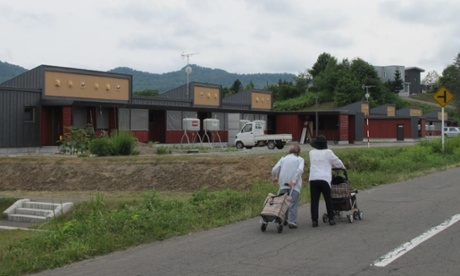
Yubari, in Hokkaido, has the oldest population in Japan ... and it’s just getting older. All photographs: Richard Hendy Few cities in the developed world can have been put as comprehensively through the wringer as Yubari, on Japan’s northernmost island of Hokkaido and known in its heyday as the capital of coal. From a peak of just shy of 120,000 people in 1960, Yubari’s population plummeted to 21,000 in 1990, the year the last colliery closed and the last miners fled. It has since more than halved again, to below 10,000, as those who stayed on aged and died or drifted away in the wake of the city’s tumultuous 2007 bankruptcy.Yubari now is a city of superlatives, mostly invidious ones. Demographically, it is the oldest city in Japan, probably the world, and possibly ever to have existed, with a median age of 57 in 2010 that is set to rise to 65 by 2020, at which time more people will be over 80 than under 40, making Yubari perhaps the world’s first pensioner-majority city. The population is still falling precipitously, and there are fewer children, proportionately, than in any other city in Japan, with barely one in 20 of the population under the age of 15 – about a dozen people die in Yubari for every child born. Following the bankruptcy, Yubari has the most onerous debt burden and close to the weakest finances of any Japanese city, while its bureaucrats and mayor draw the lowest salaries (about £18,000 in the mayor’s case). For the city as a whole, between 1998 and 2012, per capita taxable income fell by nearly a third.Seven years after the bankruptcy and five since my last visit, I was eager to return to Yubari, for much has changed – not all for the worse. Spurred by the rigours of bankruptcy, the schools, of which Yubari (like much of Japan) had far too many, have been consolidated into a single elementary, junior high and high school apiece. The wherewithal has somehow been found to build two tracts of considerately single-storey public housing. Jobs have been created with the arrival of a Chinese herbal medicine factory. And Japan’s oldest city in 2011 elected the country’s youngest mayor: the dashing and energetic Naomichi Suzuki, who had just turned 30 on election and who has come to relish his role as PR costermonger-in-chief for Yubari produce. Were there lessons in the Yubari experience for other devastated resource-dependent or single-industry cities – cities like Detroit – which followed its now minuscule Japanese cousin into bankruptcy last year?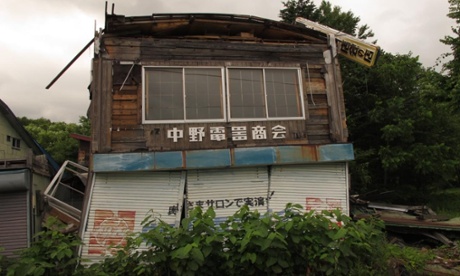
The remains of an electrical goods store in the Yubari district of Nanbu, which has lost one quarter of its population in the past five years An epochal national event had occurred in the five years I had been away, too: in 2011, Japan’s population began unambiguously to drop, making the nation the first and so far only important developed country with a declining population. Close to 85% of municipalities in Japan are shrinking, compared to fewer than than 5% of local authorities in England and Wales. Demography is front-page news in Japan: alarmism reached feverish levels this spring with the publication of a report asserting that more than half of Japan’s municipalities are “at risk of extinction” by 2040, as their numbers of reproductive-age women halve versus 2010 – or in Yubari’s case, fall by 85% to just 100 such women in 2040.This makes Yubari fascinating as the demographic canary in the Japanese, erm, coal mine. When celebrated doctor Tomohiko Murakami, who led the post-bankruptcy downsizing of Yubari’s only hospital into a clinic (before he was disgraced in a bizarre love triangle-cum-attempted murder incident), describes contemporary Yubari as a “microcosm of Japan in 2050”, he exaggerates only mildly: by around 2060, the over-65s are projected to account for four out of every 10 Japanese – a ratio Yubari reached about a decade ago.In the late 1970s, city authorities – confronted by the imminent demise of the city’s backbone industry and pumped up by febrile talk of Japan as an emergent lifestyle superpower and oblivious to Yubari’s frigid climate (the mean annual temperature is below 6°C and the city is snowbound half the year) – threw in their lot with the fickle deity of tourism and built a vast Coal History Village theme park. It was replete with the usual attractions, such as a roller coaster and giant ferris wheel; some more outré ones, such as a World Stuffed Animal House; and plenty whose purpose cannot be fathomed from their names alone – roller luge, atomic coaster, Great Poseidon.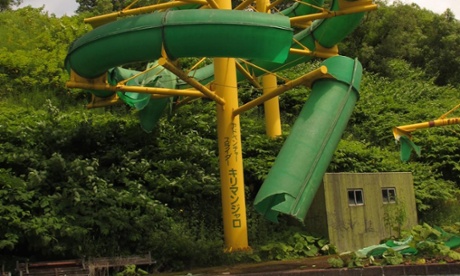
The dilapidated remains of Adventure Slider Kilimanjaro, part of the Coal History Village theme park that closed in 2006 The theme park staggered on for years with backhander subsidies from the city before going belly up in 2006. Five years ago, the odd family still strolled the carcass of the park. Now, with the facilities in an even more pronounced stage of decay, my only companion was an aggressive male stonechat, pounding out a chek-chek-chek in defence of his territory from the intruder.Yubari’s other claim to fame is its eponymous cantaloupe melon. The first pair of the season this year fetched an eye-watering £15,000 at auction, equaling the record high and making them surely the most expensive fruit ever sold. Even the melon I picked up at the airport for half price set me back £11. The melon farmers are consequently doing very nicely, though they are ageing fast, too. One souvenir emporium has come up with a radical new city mascot, Melon Bear, whose aggressive snarl and bulging veins push the boundaries of cute into the realm of the creepy. Yet Yubari’s main arterial road, its umbilical cord to the world, has recently been bypassed by an expressway, allowing all but the most dedicated tourists to give the city a miss, with a predictably calamitous impact on souvenir emporia that Melon Bear is unlikely to mitigate.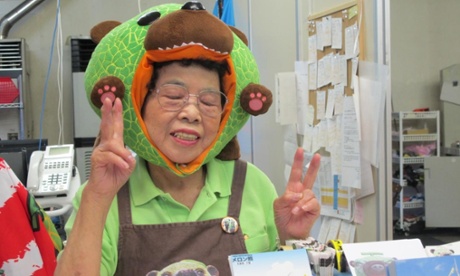
Yubari is famous for cantaloupe melons and efforts have been made to promote the industry with a cuddly mascot, Melon Bear One unheralded Yubari success story is its rewilding, although no Japanese administrator would use that expression, which smacks to them of defeatism. When the city had the money in the 1970s and 1980s, it tore down vast tracts of miners’ housing. Stand in the upper Yubari valley and gaze up at the verdant hillsides now and it is hard to imagine they were once covered with sooty tenements. Almost all trace of the coal mines, save the odd slag-heap, has been expunged. Compare this with Detroit and, say, its Packard Automotive Plant, shuttered in 1958 and still a ruin. Work remains to be done – roughly a third of Yubari’s public housing, in which half of its denizens dwell, lies empty – but the bulk of the task is over.As humanity recedes, nature returns. By a railway station on Yubari’s somnolent branch line, a man who in a small act of public spiritedness is watering the bare concrete floors of the station building (“It keeps the dust down”) points to a Sika Deer doe in the nearby undergrowth. “Unusual to see one around here until just recently.” More deer vaulted in front of my car on Yubari’s main street the following day, forcing a swerve. Good use is being made of the return of nature, too: an abandoned elementary school has been turned into a nature academy, where big-city kids can kayak down the now pristine rivers and catch stag beetles.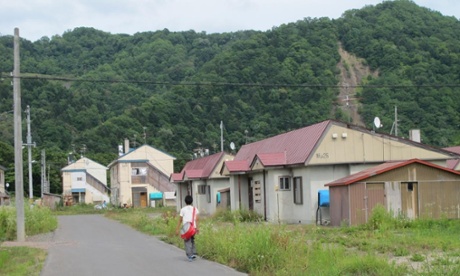
The rare sight of a pupil returning home. Most of the schools have been closed, with only one in 20 people under the age of 15 Yubari has other lessons for the rust-belts of the west, too, although the lessons may be unlearnable. There’s no graffiti, no vandalism and scarcely any crime. Whole years can elapse without a single felony. In 2013 there was less than a single crime of any description per week. Best of all, the state has not abdicated or shirked its responsibilities: there are still at least a dozen post offices, the fire engines are spit-polished and ready to respond to the monthly fire, and the public payphones, should you need one, are immaculate. Nor is the state rapacious: if you qualify, two-bedroom apartments in newish public blocks rent for around £150 a month, there are 40 sheltered housing units for the elderly that rent for less than £30 a month, and if you’re old and poor enough, someone will come and shovel your snow away for nothing.What does the future hold for Yubari? More of the same: between 2010 and 2040, the population is projected to shrink by another two-thirds. The grand folly of monument-driven tourism is over, the lessons expensively, ruinously, learned. The city’s 2012 master plan calls for an orderly retreat from the fringes to the core, with the emphasis on preventative healthcare for the old, who will increasingly have to tend to the very old. Yubari is in its last throes now, learning, with the occasional slip but a certain grace, how to die with dignity.
2014年8月15日 星期五
Yubari, Japan: a city learns how to die
訂閱:
張貼留言 (Atom)
Links of Hanching Chung
網誌存檔
-
▼
2014
(938)
-
▼
8月
(69)
- Scratch-Off Art on Subway Platforms By Photographs...
- 蘇花公路
- 「誠品生活」
- 神岡浮圳
- “女體盛“(Nyotaimori)在溫哥華Naked Sushi餐館開始供應
- 台北市第二殯儀館
- Tang-Era Stele 唐代石碑
- 花蓮富里「六十石山」金針花海
- "space junk"
- Durham
- 臺灣總督府中央研究所
- 花東縱谷
- 島根 出雲大社
- 『科学の台湾』;國立臺灣博物館建築落成啟用99年
- 壓垮樹幹: 鳥巢重逾900公斤, 由500隻鳥搭建而成的巨型鳥巢
- city of Napa
- 邵族祖靈祭Lusán(大過年)初一儀式
- 台北市行天宮
- 阪神甲子園球場
- London's talking statues
- Lotus gardens in Vietnam's capital
- Silicon Forest
- 昭和10年(1935)台灣博覽會正門;1940年1月12日臺灣總督府臺北高等學校學生凱旋遊行
- Jackson Hole,Wyoming
- 〈台北都會〉中山足球場;「國際創新創業園區」
- 台灣稻草 「草草了事」
- Istanbul's 'illegal' towers
- 新竹東門「迎㬢門」的老照片 (約當100年前)
- Shanghai Free-Trade Zone (Pudong)
- Cupertino
- 日本廣島市山體滑坡造成至少39人死亡
- 戰後關渡宮變身三部曲
- 台灣林業真相 (李根政)
- 中興大學旁河川_獨木舟
- 武塔莎韻紀念公園
- 東京.足利公園的紫藤花 (May)
- 游香港 Jade Lai
- The Churchill War Rooms
- 上海Calypso餐館
- Yasukuni Shrine (靖国神社 or 靖國神社, Yasukuni Jinja)
- The Scott and Hella McVay Poetry Trail, D&R Greenway
- 台中市的快捷巴士「BRT」確屬「菜籃貨」(林碧堯)
- 台大運走千年紅檜
- 全球最具影響力城市(Forbes)
- The city is believed to predate the Harappan civil...
- 1950年代台北亭仔腳的書報攤
- Yubari, Japan: a city learns how to die
- The Lurie Garden
- 台南二中
- 草悟道、小書店、范特喜
- Abandoned Athens Olympic 2004 venues, 10 years on
- 美國警察軍隊化; NYC Subway Performers: We're Being Over-...
- :十八份拐圳步道
- Kyoto's Sagano Bamboo Forest
- 旗津人力三輪車
- 苦茶之家
- 花蓮海岸山脈的超級月亮
- 台北公車近幾月大搞為愛啟程
- 高雄氣爆災區測出丙烯外洩
- 【新北投梅庭】于右任故居
- University of Essex本部Colchester 的學生宿舍介紹
- 台北市萬華區「寶斗里」「清雲閣」
- Spectra: the dazzling column of light over London
- 横浜Sankei-en 三溪園,「一保堂茶舗による お茶の淹(い)れ方教室」
- 台北市 甘州街
- 高雄國賓大飯店
- La Jolla海邊的愛情故事。
- Paris: What to See and What To Skip
- Copenhagen: What to See and What to Skip
-
▼
8月
(69)
沒有留言:
張貼留言